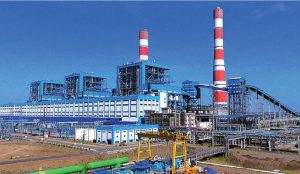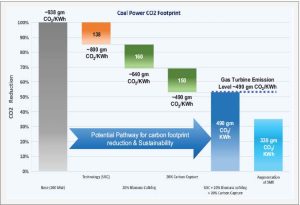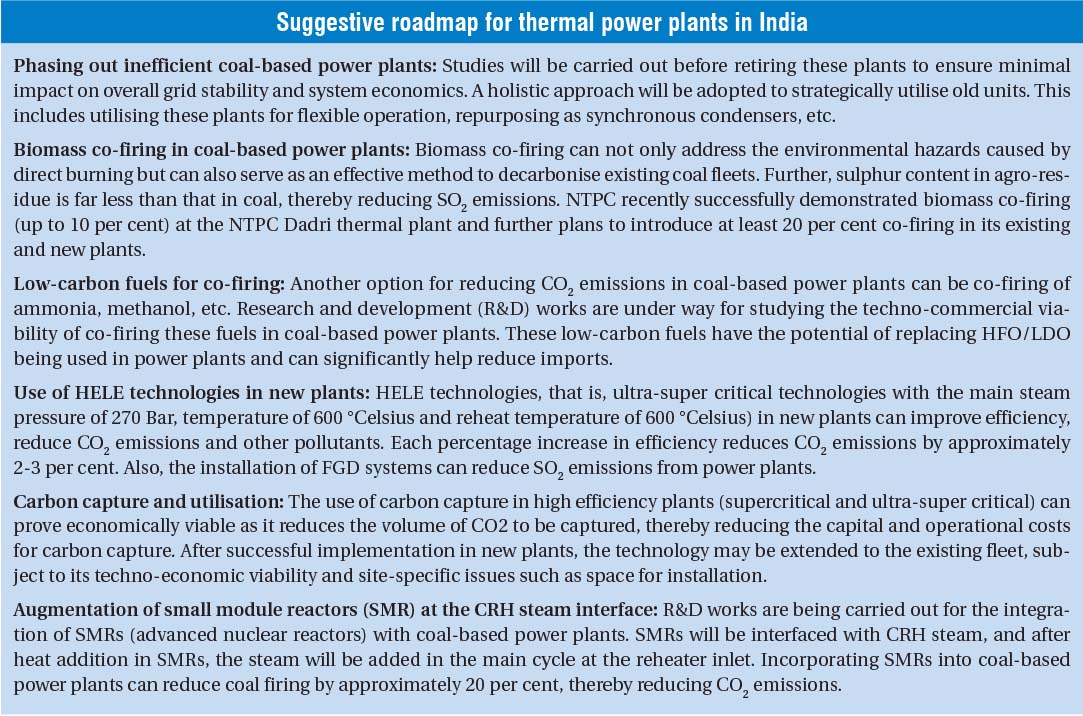

 By Ujjwal Kanti Bhattacharya, Former Director (Projects); Pankaj Kumar Gupta, General Manager (Energy Transition and Policy Research); Suneet Mehta, Dy. General Manager (Energy Transition and Policy Research), NTPC Limited
By Ujjwal Kanti Bhattacharya, Former Director (Projects); Pankaj Kumar Gupta, General Manager (Energy Transition and Policy Research); Suneet Mehta, Dy. General Manager (Energy Transition and Policy Research), NTPC Limited
Challenges for India’s power sector
In India, fossil fuels have historically met the majority of the energy needs across all sectors. However, following the commitments made at COP26, there is a widespread assumption that coal usage must stop to achieve the net zero emission (NZE) targets. Some countries have already committed to phasing out coal-based power plants in their pursuit of NZE. These are mostly developed countries with slower growing economies and access to relatively inexpensive renewable energy. However, in comparison, India is a fast growing economy that relies heavily on coal for energy security. Coal remains the dominant source of energy in India as it is relatively cheap and readily available. The greatest challenge for India in such a scenario is to meet the power demand in an affordable, reliable and environmentally acceptable way. The country’s electricity demand is expected to increase manyfold owing to significant GDP growth anticipated over the next two decades. The per capita consumption of electricity in India stood at 1,297 kWh in 2022-23, significantly lower than that of developed countries. The per capita consumption of India is projected to rise to 3,000 kWh by 2040.
 Currently, coal-based power plants are the primary source of electricity generation in India and the trend is likely to continue beyond 2050 due to the growing energy demand, and challenges associated with the installation of non-fossil-based sources, intermittency of renewables, non-availability of commercially viable large-scale storage solutions, grid stability, etc. Further, India has the fifth largest coal reserves in the world, with a major portion of employment tied to the mining industry and coal-based power plants. Thus, completely phasing out coal plants in such a scenario poses many other challenges such as economic and social hardships due to loss of employment and power affordability issues. These challenges need to be identified and a comprehensive approach and roadmap must be adopted for a gradual transition.
Currently, coal-based power plants are the primary source of electricity generation in India and the trend is likely to continue beyond 2050 due to the growing energy demand, and challenges associated with the installation of non-fossil-based sources, intermittency of renewables, non-availability of commercially viable large-scale storage solutions, grid stability, etc. Further, India has the fifth largest coal reserves in the world, with a major portion of employment tied to the mining industry and coal-based power plants. Thus, completely phasing out coal plants in such a scenario poses many other challenges such as economic and social hardships due to loss of employment and power affordability issues. These challenges need to be identified and a comprehensive approach and roadmap must be adopted for a gradual transition.
Achieving NZE often implies ending coal usage. However, developing countries such as India, with faster growing economies and large coal reserves, must accelerate the deployment of low-emission coal technologies to achieve their NZE targets. This involves co-firing of low-carbon fuels, adoption of high efficiency and low emission (HELE) technologies, use of carbon capture and utilisation (CCU), augmentation of small module reactors (SMRs) in coal plants, etc.
In light of these considerations and the challenges associated with the installation and integration of large-scale renewable capacity, decarbonising coal-based power plants has emerged as an equally important aspect of achieving the COP26 commitments. Therefore, there is a need to prioritise the adoption of renewables as well as take all the possible measures for the decarbonisation of coal-based power plants.
 Importance of coal in the Indian economy
Importance of coal in the Indian economy
Coal mining and coal-based power plants are two core industries in India, providing employment to around 3.6 million people directly or indirectly. Further, India’s railway sector and various industries including logistics, iron/steel, aluminium and cement rely heavily on India’s domestic coal.
Given India’s abundant coal reserves, coal is an important asset for the country’s energy security and a key revenue source for the government through taxes, royalty, rent, etc. For instance, Indian Railways derives more than 46 per cent of its freight revenue from coal and uses this income to subsidise passenger fares, particularly benefitting the poorer segments of society. Any reduction in fare subsidies shall impact the underprivileged section of society. In addition, Indian Railways employs around 1.3 million people, and any reduction in the transportation of coal will impact such employment opportunities.
Further, the limited manufacturing capacity of PV cells, lithium-ion batteries, etc. could increase dependence on imports, and raise socio-economic issues such as limited employment opportunities.
Therefore, coal plays an important role in the Indian economy, not only as a primary energy source but also in ensuring socio-economic security.
Green chemical production using carbon capture
The captured CO2 from flue gases can be utilised for the production of green chemicals. For example, the captured CO2 can be catalytically hydrogenated (using green hydrogen) to synthesise methanol/ethanol. Another application involves using captured CO2 for the production of green ammonia and urea. By capturing CO2 and nitrogen from flue gases and mixing them with green hydrogen can produce ammonia and urea for use as a fertiliser (green prilled urea). This can help reduce CO2 emissions and bridge the gap between urea demand and supply.
 The economic feasibility of CO2 utilisation routes is crucial for its industrial application. At present, green methanol and 4G ethanol costs (produced from CO2 capture and green hydrogen) are comparatively higher than the cost of production from conventional methods. However, the cost of green chemicals will significantly decrease when green hydrogen (which contributes to approximately 75-85 per cent of the overall green chemical cost) becomes available at a cost-competitive price. Further, incentives in the form of carbon credits can help in developing a sustainable value chain for green chemicals.
The economic feasibility of CO2 utilisation routes is crucial for its industrial application. At present, green methanol and 4G ethanol costs (produced from CO2 capture and green hydrogen) are comparatively higher than the cost of production from conventional methods. However, the cost of green chemicals will significantly decrease when green hydrogen (which contributes to approximately 75-85 per cent of the overall green chemical cost) becomes available at a cost-competitive price. Further, incentives in the form of carbon credits can help in developing a sustainable value chain for green chemicals.
The green chemicals produced using carbon capture can be used in the transport sector (replacement of petrol/diesel), energy sector (DG sets, boilers, fuel for gas turbines), blending with LPG, etc. They can reduce CO2 and particulate matter emissions, thereby accelerating the transition to a circular economy.

Upcoming challenges and the way forward
Some of the challenges that India faces in achieving NZE targets include the exponential increase in power demand, reducing emissions, ensuring reliable, sustainable and affordable power, land acquisition, establishment of manufacturing facilities for renewable energy, intermittency of renewables, non-availability of commercially viable large-scale storage solutions, grid stability/reliability issues with the addition of renewable energy.
India has one of the youngest coal fleets in the world, with more than 60 per cent of the capacity less than a decade old. Maintaining efficiency and reducing emissions from these plants will play a key role in India’s path towards NZE.
Initially, decarbonisation through HELE USC technology, 20 per cent biomass firing and 20 per cent carbon capture can bring emissions to the level of a gas power plant, creating a pathway for future transition to NZE. Increasing carbon capture above 90 per cent with advancements in technologies, using the above-mentioned technologies and integration with SMR can result in net negative CO2 emissions, effectively removing CO2 from the atmosphere.
 A comprehensive roadmap, supported by a strong regulatory/policy framework, is required for achieving India’s NZE targets with a focus on addressing India-specific challenges.
A comprehensive roadmap, supported by a strong regulatory/policy framework, is required for achieving India’s NZE targets with a focus on addressing India-specific challenges.
Some basic considerations for framing regulations should include prioritising high efficiency plants, encouraging HELE technologies, promoting biomass/ammonia/methanol co-firing, adopting CCU technologies, facilitating R&D for these technologies, adopting a round-the-clock renewable energy framework (instead of standalone renewable energy), strengthening the ancillary system framework, supporting affected communities, benefiting Energy Charge Rate (ECR) for reducing emissions etc.
Coal-based power plants have the potential to remain an integral part of the Indian grid even in the NZE era, creating a win-win situation by providing the cheapest solution for decarbonisation, facilitating the integration of variable renewable energy into the grid, utilising coal resources, and providing reliable, affordable and sustainable power along with socio-economic security.
